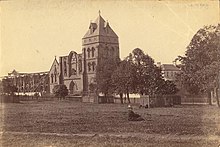James Dempsey (builder)
After an outstandingly scrupulous hearing at Wicklow (north of Wexford), Dempsey was found not guilty of both murder charges but was sentenced to transportation for life as a rebel.
[2] Dempsey sailed for Australia on the transport ship ‘Atlas’, which left Cork in southern Ireland on 6 July 1802 and reached Sydney in October.
[4] Since by 1810, perhaps as early as 1806, Dempsey was overseer of the government stonemasons and claimed to have given satisfaction to ‘the Governor, his Engineers And Officers in Command’, it can be assumed that he had brought building skills to the colony from Ireland.
[5] He worked on the stone bridge over the Tank Stream in 1811 and was in charge of the builders erecting the Rum Hospital (surviving portions now used as Parliament House and the Sydney Mint) from 1812 until 1815.
[8] He continued to practise his own skills in carving stone and in 1815 was paid the large sum of £29 for preparing the inscription for the new Military Barracks near his home.
Before Father Jeremiah Francis O'Flynn arrived in the colony in 1817, a group of Catholic men and women met regularly at Dempsey's house in Kent Street to recite the rosary and to sing Vespers.
The site of what became St Mary's Cathedral near Hyde Park Barracks had been chosen by James Meehan, the deputy surveyor-general who had also been transported from Ireland for his support to the 1798 rebellion.
[16] The gravemarker was removed to Botany Cemetery when Devonshire Street was closed to allow for the construction of Central railway station in 1901 and its text was transcribed before it was destroyed in the 1980s.


